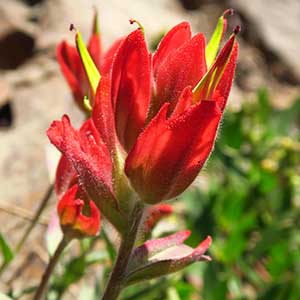Castilleja linariifolia
Castilleja elmeri
desert paintbrush, desert paintbursh, linaria-leaf Indian paintbrush, narrow leaf paintbrush, narrow-leaf Indian paintbrush, Wyoming Indian paintbrush, Wyoming or narrow-leaf or long-leaf paintbrush, Wyoming paintbrush
Elmer's Indian paintbrush, Elmer's paintbrush, Wenatchee Indian paintbrush, Wenatchee paintbrush
few to many, ascending to erect, much-branched, glabrous proximally, hairy distally, sometimes glabrous or hairy throughout, hairs sparse, sometimes dense, spreading to slightly retrorse, short to long, ± stiff, eglandular.
solitary or few to many, erect to ascending, sometimes slightly curved at base, unbranched, rarely branched, hairs moderately dense, spreading, medium length, soft, mixed with shorter eglandular and stipitate-glandular ones, at least on distal 1/2 of stem.
± yellow to gray-green, sometimes becoming ± purple, linear to narrowly lanceolate, (1–)2–10 cm, not fleshy, rarely ± thickened and fleshy, margins plane, involute, 0–3(–5)-lobed, apex acute or acuminate;
lobes spreading, linear, apex acute to acuminate.
green, rarely purple-tinged, linear-lanceolate, sometimes linear or lanceolate, 1.3–6.5 cm, not fleshy, margins plane, flat or involute, entire, apex acute.
4–20 × 2–7.5 cm;
bracts red to red-orange throughout, sometimes pale green, yellow, magenta, pink-purple, or white throughout, or proximally pale greenish to straw colored, distally colored as above, lanceolate to narrowly lanceolate or narrowly oblong, 3(–5)-lobed;
lobes spreading to ascending, narrowly lanceolate to linear, shorter than central lobe, arising in proximal 1/3, apex obtuse to acuminate.
2.5–9 × 1.5–3 cm;
bracts red, crimson, scarlet, pink, magenta, red-orange, burnt orange, orange, pale yellow, or whitish throughout, or proximally greenish, distally as stated above, oblong, narrowly obovate, elliptic-oblong, or narrowly ovate, 0(–5)-lobed, rarely with 1 or 2 pairs of short, usually distal lobes;
lobes ascending, lanceolate, very short, arising from distal edge, apex rounded to obtuse.
0 mm.
often slightly curved, 25–45 mm;
tube 11–22(–25) mm;
beak exserted, longer than calyx lobes, usually projecting through abaxial cleft;
beak adaxially yellow-green or green, 9–21(–24) mm;
abaxial lip deep green, reduced, often visible in exserted sideways through abaxial calyx cleft, 0.5–3 mm, 10–15% as long as beak;
teeth incurved, green or whitish, 5–2(–3) mm.
straight, 20–33 mm;
tubes 13–18 mm;
beak, and sometimes abaxial lip, partially to fully exserted;
beak adaxially green to yellowish, 8–15 mm;
abaxial lip incurved, green, thickened, 2–3 mm, 20–33% as long as beak;
teeth ascending or incurved, green, 0.5–1 mm.
proximally greenish, whitish, or yellowish, distally colored as bracts, 18–30(–35) mm;
abaxial clefts 10–20(–22) mm, adaxial 2–6(–12) mm, abaxial ca. 70% of calyx length, adaxial ca. 20–25% of calyx length, deeper than laterals, lateral 1.5–5(–6) mm, 12–17% of calyx length;
lobes curved slightly toward adaxial side, narrowly oblong to narrowly lanceolate, apex acute.
proximally green to pale green, distally colored as bracts, 15–25 mm;
abaxial and adaxial clefts 5–14 mm, 33–50% of calyx length, deeper than laterals, lateral 1–4 mm, 6–20% of calyx length;
lobes lanceolate to narrowly triangular, apex rounded to obtuse.
= 24, 48.
= 48.
Castilleja linariifolia
Castilleja elmeri
Castilleja linariifolia is widespread in the western United States and is important to Native Americans as a source of dyes and for medicinal and ceremonial purposes (D. E. Moerman 1998). It is the state flower of Wyoming. Castilleja linariifolia is closely associated with, and undoubtedly parasitic on, the roots of sagebrush, Artemisia tridentata. The bracts are usually red to red-orange, with uncommon yellow-bracted variants. On the eastern slope of the Sierra Nevada in California, most populations have pink-purple to magenta bracts, and at least one population has almost pure white bracts. Plants associated with hot springs in the Ash Meadows area of Nye County, Nevada, are unusually tall and have somewhat fleshy leaves. Castilleja linariifolia stems are usually glabrous, but pubescent stems are sporadic across its range. However, in the Mt. Charleston area of the Spring Mountains, in southern Nevada, most plants are pubescent, ranging from an inconspicuous layer to a fairly dense and obvious indument. These plants have been called forma omnipubescens Pennell. Elsewhere, especially in central and northern Arizona, individuals with short-pubescent stems are intermingled with more typical plants. In addition, late-blooming forms associated with hot spring sites in the eastern Mojave Desert are particularly thick-stemmed and vigorous. Hybrids between C. linariifolia and C. scabrida are known from Garfield County, Utah. Castilleja linariifolia is parapatric with the similar C. wootonii in central New Mexico. Castilleja linariifolia is reported to hybridize with C. chromosa, C. flava, and C. miniata. A possible hybrid with C. septentrionalis was named C. ×cognata Greene.
(Discussion copyrighted by Flora of North America; reprinted with permission.)
The bracts and inflorescences of Castilleja elmeri can be red, crimson, scarlet, pink, magenta, red-orange, burnt orange, orange, pale yellow, or whitish. While the coloration is highly variable between local populations, it is usually uniform and consistent within them. It is found primarily in the Wenatchee Mountains of Washington, where it is often on serpentine, but it ranges northward in the Cascades into extreme southern British Columbia, apparently on non-serpentine substrates. Hybrids with C. miniata var. miniata, C. parviflora var. albida, and C. thompsonii have been found in the eastern Cascades of Washington, and a similar hybrid swarm with C. thompsonii is reported from southern British Columbia.
(Discussion copyrighted by Flora of North America; reprinted with permission.)


